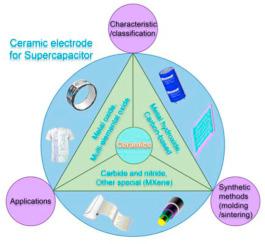Journal of Materiomics ( IF 9.4 ) Pub Date : 2021-03-10 , DOI: 10.1016/j.jmat.2021.03.001 Xiaojun Zeng , Hanbin Song , Zong-Yang Shen , Martin Moskovits

|
Supercapacitors (SCs) are one of the most promising electrical energy storage technologies systems due to their fast storage capability, long cycle stability, high power density, and environmental friendliness. Enormous research has focused on the design of nanomaterials to achieve low cost, highly efficient, and stable electrodes. Ceramic materials provide promising candidates for SCs electrodes. However, the low specific surface area and relatively low surface activity severely hinder the SCs performance of ceramic materials. Therefore, the basic understanding of ceramic materials, the optimization strategy, and the research progress of ceramic electrodes are the key steps to enable good electrical conductivity and excellent electron transport capabilities, and realize economically feasible ceramic electrodes in industry. Herein, we review recent achievements in manufacturing the ceramic electrodes for SCs, including metal oxide ceramics, multi-elemental oxide ceramics, metal hydroxide ceramics, metal sulfide ceramics, carbon-based ceramics, carbide and nitride ceramics, and other special ceramics (MXene). We focus on the unique and key factors in the component and structural design of ceramic electrodes, which correlate them with SCs performance. In addition, the current technical challenges and perspectives of ceramic electrodes for SCs are also discussed.
中文翻译:

超级电容器用陶瓷的进展与挑战
超级电容器(SC)由于其快速存储能力、长循环稳定性、高功率密度和环境友好性而成为最有前途的电能存储技术系统之一。大量研究集中在纳米材料的设计上,以实现低成本、高效和稳定的电极。陶瓷材料为 SCs 电极提供了有前景的候选材料。然而,较低的比表面积和相对较低的表面活性严重阻碍了陶瓷材料的 SCs 性能。因此,对陶瓷材料的基本认识、优化策略和陶瓷电极的研究进展是实现良好的导电性和优异的电子传输能力,实现工业上经济可行的陶瓷电极的关键步骤。在此处,我们回顾了近年来在SCs陶瓷电极制造方面的成就,包括金属氧化物陶瓷、多元素氧化物陶瓷、金属氢氧化物陶瓷、金属硫化物陶瓷、碳基陶瓷、碳化物和氮化物陶瓷以及其他特殊陶瓷(MXene)。我们专注于陶瓷电极的组件和结构设计中的独特和关键因素,这些因素将它们与 SCs 性能相关联。此外,还讨论了当前用于 SCs 的陶瓷电极的技术挑战和前景。我们专注于陶瓷电极的组件和结构设计中的独特和关键因素,这些因素将它们与 SCs 性能相关联。此外,还讨论了当前用于 SCs 的陶瓷电极的技术挑战和前景。我们专注于陶瓷电极的组件和结构设计中的独特和关键因素,这些因素将它们与 SCs 性能相关联。此外,还讨论了当前用于 SCs 的陶瓷电极的技术挑战和前景。

























 京公网安备 11010802027423号
京公网安备 11010802027423号